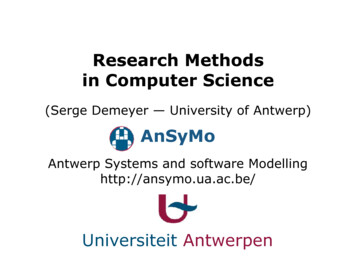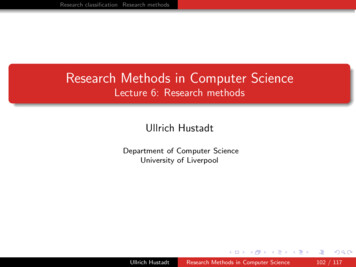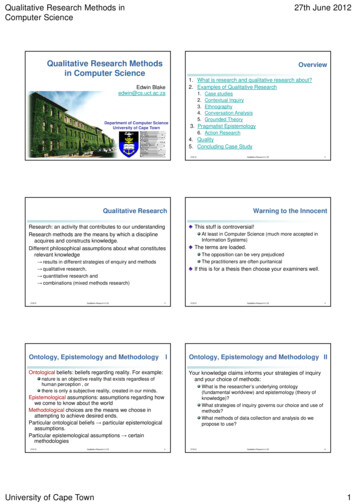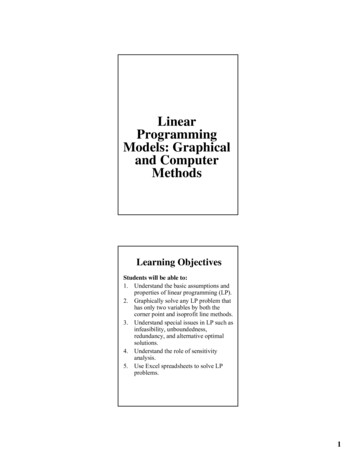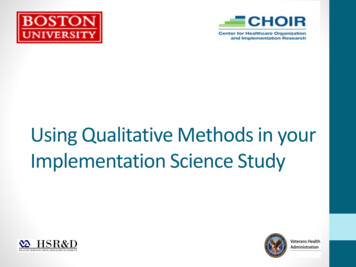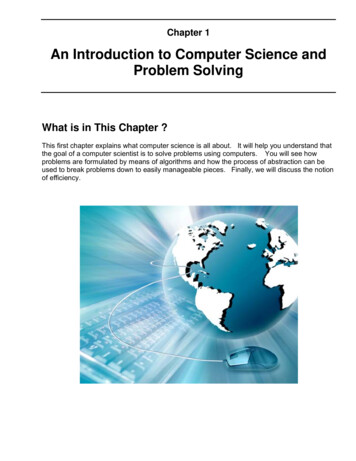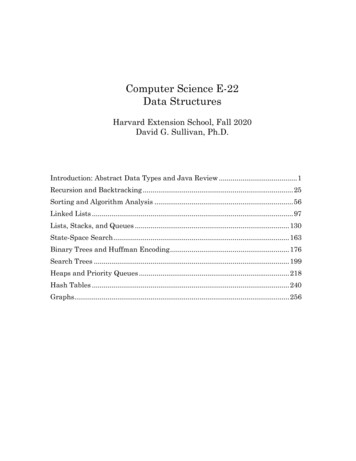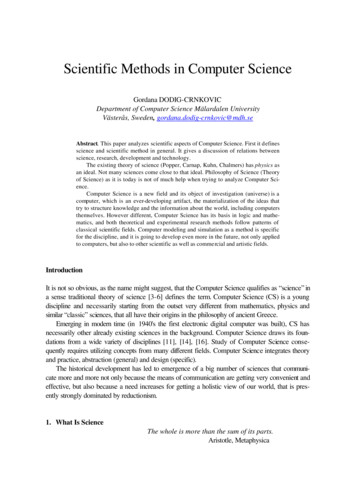
Transcription
Scientific Methods in Computer ScienceGordana DODIG-CRNKOVICDepartment of Computer Science Mälardalen UniversityVästerås, Sweden, gordana.dodig-crnkovic@mdh.seAbstract. This paper analyzes scientific aspects of Computer Science. First it definesscience and scientific method in general. It gives a discussion of relations betweenscience, research, development and technology.The existing theory of science (Popper, Carnap, Kuhn, Chalmers) has physics asan ideal. Not many sciences come close to that ideal. Philosophy of Science (Theoryof Science) as it is today is not of much help when trying to analyze Computer Science.Computer Science is a new field and its object of investigation (universe) is acomputer, which is an ever-developing artifact, the materialization of the ideas thattry to structure knowledge and the information about the world, including computersthemselves. However different, Computer Science has its basis in logic and mathematics, and both theoretical and experimental research methods follow patterns ofclassical scientific fields. Computer modeling and simulation as a method is specificfor the discipline, and it is going to develop even more in the future, not only appliedto computers, but also to other scientific as well as commercial and artistic fields.IntroductionIt is not so obvious, as the name might suggest, that the Computer Science qualifies as “science” ina sense traditional theory of science [3-6] defines the term. Computer Science (CS) is a youngdiscipline and necessarily starting from the outset very different from mathematics, physics andsimilar “classic” sciences, that all have their origins in the philosophy of ancient Greece.Emerging in modern time (in 1940's the first electronic digital computer was built), CS hasnecessarily other already existing sciences in the background. Computer Science draws its foundations from a wide variety of disciplines [11], [14], [16]. Study of Computer Science consequently requires utilizing concepts from many different fields. Computer Science integrates theoryand practice, abstraction (general) and design (specific).The historical development has led to emergence of a big number of sciences that communicate more and more not only because the means of communication are getting very convenient andeffective, but also because a need increases for getting a holistic view of our world, that is presently strongly dominated by reductionism.1. What Is ScienceThe whole is more than the sum of its parts.Aristotle, Metaphysica
Talking about “science” we actually mean plurality of different sciences. Different sciences differvery much from each other. The definition of science is therefore neither simple nor unambiguous.See [1] and [2] for several possible classifications. For example, history and linguistics are oftenbut not always catalogued as sciences.1.1 Classical SciencesLogic&Mathematics1Natural Sciences(Physics,Chemistry,Biology, )2Social Sciences(Economics,Sociology,Anthropology, )3The Humanities(Philosophy, History,Linguistics )4Culture(Religion, Art, )5Figure 1. What is science? One possible view.The figure above suggests that sciences have specific areas of validity. The logic and mathematics (the most abstract and at the same time the most exact sciences) are more or less importantpart of every other science. They are very essential for physics, less important for chemistry andbiology1, and their significance continues to decrease towards the outer regions of our scheme.The logical reasoning as a basis of all human knowledge is of course present in every kind ofscience as well as in philosophy.The structure of Figure 1 may be seen in analogy with looking into a microscope. With thehighest resolution we can reach the innermost region. Inside the central region logic is not only thetool used to make conclusions. It is at the same time the object of investigation. Even though bigparts of mathematics can be reduced to logic (Frege, Rusell and Whitehead) the complete reduction is impossible.On every step of zooming out, the inner regions are given as prerequisites for the outer ones.Physics is using mathematics and logic as tools, without questioning their internal structure. In thatway information about the deeper structure of mathematics and logic is hidden looking from theoutside. In much the same way, physics is a prerequisite for chemistry that is a hidden level insidebiology etc.
The basic idea of Figure 1 is to show in a schematic way the relation between the three maingroups of sciences (logic & mathematics, Natural Sciences and Social Sciences) as well as theconnections to thought systems represented by the Humanities.Finally the whole body of human knowledge, scientific and speculative is immersed in and impregnated by the cultural environment.Table 1. Sciences, objects and methodsSCIENCEOBJECTSDOMINATING METHODSimpleReductionism (analysis)Logi c &MathematicsAbstract objects:propositions, numbers, .DeductionNatural Sc iencesNatural objects: physical bodies,fields and interactions, livingorganisms .Hypothetico-deductive methodSocial SciencesSocial objects:human individuals, groups,society, .Hypothetico-deductive method HermeneuticsHumanitiesCultural objects: human ideas,actions and relationships,language, artefacts HermeneuticsComplexHolism (synthesis)1.2 Sciences Belonging to Several FieldsThe development of human thought parallel to the development of human society has led to anemergence of sciences that do not belong to any of the classic types we have described earlier,but rather share common parts with several of these.Many of the modern sciences are of interdisciplinary, “eclectic” type. It is a trend for new sciences to search their methods and even questions in very broad areas. It can be seen as a result ofthe fact that the communications across the borders of different scientific fields are nowadaysmuch easier and more intense than before.Computer Science for example includes the field of artificial intelligence that has its roots inmathematical logic and mathematics but uses physics, chemistry and biology and even has partswhere medicine and psychology are very important.We seem to be witnessing an exciting paradigm shift:We should, by the way, be prepared for some radical, and perhaps surprising, transformations of the disciplinary structure of science (technology included) as information processing pervades it. In particular, as we become more aware of the detailed information processes that go on in doing science, the sciences will find themselves increasingly taking ameta-position, in which doing science (observing, experimenting, theorizing, testing, archiving,) will involve understanding these information processes, and building systems that dothe object-level science. Then the boundaries between the enterprise of science as a whole(the acquisition and organization of knowledge of the world) and AI (the understanding ofhow knowledge is acquired and organized) will become increasingly fuzzy.Allen Newell, Artif. Intell. 25 (1985) 3.Here we can find a potential of the new synthetic (holistic) worldview that is about to emerge inthe future.
2. The Scientific MethodThe scientific method is the logical scheme used by scientists searching for answers to the questions posed within science. Scientific method is used to produce scientific theories, including bothscientific meta-theories (theories about theories) as well as the theories used to design the tools forproducing theories (instruments, algorithms, etc). The simple version looks something like this (seealso Figure 2):1. Pose the question in the context of existing knowledge (theory & observations).It can be a new question that old theories are capable of answering (usually the case), or thequestion that calls for formulation of a new theory.2. Formulate a hypothesis as a tentative answer.3. Deduce consequences and make predictions.4. Test the hypothesis in a specific experiment/theory field. The new hypothesis must prove to fitin the existing world-view (1, “normal science”, according to Kuhn). In case the hypothesisleads to contradictions and demands a radical change in the existing theoretical background, ithas to be tested particularly carefully. The new hypothesis has to prove fruitful and offer considerable advantages, in order to replace the existing scientific paradigm. This is called “scientific revolution” (Kuhn) and it happens very rarely. As a rule, the loop 2-3-4 is repeated withmodifications of the hypothesis until the agreement is obtained, which leads to 5. If major discrepancies are found the process must start from the beginning, 1.5. When consistency is obtained the hypothesis becomes a theory and provides a coherent set ofpropositions that define a new class of phenomena or a new theoretical concept. The resultshave to be published. Theory at that stage is subject of process of ”natural selection” amongcompeting theories (6). A theory is then becoming a framework within which observations/theoretical facts are explained and predictions are made. The process can start from thebeginning, but the state 1 has changed to include the new theory/improvements of old theory.Figure 2 describes very generally the logical structure of scientific method used in developing new theories. As the flow diagram suggests, science is in a state of permanent changeand development.The one of the most important qualities of science is its provisional character: it is subject tocontinuous re-examination and self-correction.EXISTING THEORIESAND OBSERVATIONSHYPOTHESISPREDICTIONS123Hypothesis must bethoroughly redefinedHypothesis must beadjustedTESTS AND NEWOBSERVATIONSSELECTION AMONGCOMPETINGTHEORIES64Consistency achievedOLD THEORY CONFIRMED(within a new context) orNEW THEORY PROPOSED5THE SCIENTIFIC METHODFigure 2. Diagram describing iterative nature of the hypothetico-deductive method
It is crucial to understand that the logic of science is recursive. Prior to every observation/experiment/theoretical test there is a hypothesis (2) that has its origins in the pre-existing bodyof knowledge (1). Every experimental/observational result has a certain world-view built-in. Or, tosay it by Feyerabend [7], every experimental data is “theory-contaminated”.Here it is also interesting to mention that designing new experimental equipment or procedurematch the same scheme:(1) Start from existing theoretical/experimental framework; (2) Formulate the problem; (3) Infer consequences; (4) Test if it works as expected; (5-6) Accept.As soon as a piece of equipment or method is designed and used as a tool for testing new hypotheses, it is supposed that it works according to the design specification. The detailed information about its internal structure is therefore hidden. The same is true for the existing theoreticalcontext of a theory under development- it is taken for granted.The scheme of the scientific method in Figure 2 is without a doubt an abstraction and simplification. Critics of the hypothetico-deductive method would argue that there is in fact no such thingas “the scientific method”. By the term “the scientific method” they actually mean the concrete setof rules defining how to proceed in posing new relevant questions and formulating successful hypotheses. Of course, no such magic recipe exists!The important advantage of the scientific method is that it is impartial:2 one does not have tobelieve a given researcher, one can (in principle) repeat the experiment and determine whethercertain results are valid or not. The question of impartiality is closely related to openness and universality of science, which are its fundamental qualities. A theory is accepted based in the firstplace on the results obtained through logical reasoning, observations and/or experiments. The results obtained using the scientific method have to be reproducible. If the original claims are notverified, the causes of such discrepancies are exhaustively studied.All scientific truths are provisional. But for a hypothesis to get the status of a theory it is necessary to win the confidence of the scientific community. In the fields where there are no commonlyaccepted theories (as e.g. explanation of the process of creation of the universe- where the “bigbang” hypothesis is the most popular one) the number of alternative hypotheses can constitute thebody of scientific knowledge.3. Science, Research, TechnologyIn his famous reflections on science and technology, Aristotle has identified some key distinctionsthat are still frequently quoted and even used to analyze modern science and technology.According to Aristotle there are important distinctions between science (episteme) and technology (techne) in their objects, principles of change, ends, goals and activities. The recent distinctions add methods, innovation form, types of result, and time perspective.
3.1 Aristotle's Science contra eablePrinciple ofmotioninsideoutsideEndknowing thegeneralknowing the concreteActivitytheoria: end initselfpoiesis: end in som ethingelseMethodabstractionmodeling nnovation formdiscoveryinventionType of resultlaw -likestatementsrule-like statementsTime perspectivelong-termshort-termTable 2. Standard distinctions: science vs. technology3.2 Modern Science contra TechnologyTraditional sharp binary distinctions between science and technology seem however to fail whenapplied to contemporary science, because the underlying concepts of science are out-dated. Today's science is much more complex and heterogeneous than science of the Aristotle’s time (thecontemporary relations are illustrated by Figure 3), the fact that modern theory of science have totake into account.That is why philosophy of science is in vital need of a deeper, more realistic understanding ofcontemporary sciences. The time is ripe for paradigm change in philosophy of scien
This paper analyzes scientific aspects of Computer Science. First it d efines science and scientific method in general. It gives a discussion of relations between science, research, development and tec hnology. The existing theory of science (Popper, Carnap, Kuhn, Chalmers) has physics as an ideal. Not many sciences come close to that ideal. Philosophy of Science (Theory

